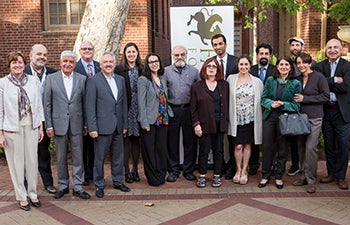New Horizons
Neda Maghbouleh began her presentation at the inaugural USC Dornsife-Farhang Foundation Iranian Studies Initiative Conference quoting an interview she had conducted with an Iranian American teenager named Soraya.
“I didn’t like myself; I thought I was ugly,” Soraya told Maghbouleh, assistant professor of sociology at the University of Toronto, Scarborough. “Kids would say, ‘Wow, you have a uni-brow.’ Or, ‘Bin Laden is your father.’ ”
Soraya was just one of the many young adults Maghbouleh highlighted in her talk “Iranian Americans and the Everyday Politics of Race.” Using her qualitative research, Maghbouleh hopes to promote a culture that is more inclusive of Iranians living in North America, thereby helping youths such as Soraya.
The full-day conference, held April 10 on USC’s University Park campus, was titled “Iranian Culture and Diaspora.” It was organized by the USC Dornsife Middle East Studies Program (MESP) as part of the Iranian Studies Initiative, which is supported by the Farhang Foundation, an organization that promotes the study of Iranian art and culture.
The event brought together top scholars in the fields of sociology, anthropology, art history, literature, communications and cinematic arts to discuss how Iranians living in diaspora integrate their own culture into that of their host or adoptive nations.
“We wanted to organize something broad that would engage a great number of our students and faculty — whether they are specifically working on Iranian studies or not,” said Laurie Brand, Robert Grandford Wright Professor, and professor of international relations and Middle East studies. “We hope to generate further awareness of the Iranian studies courses and programs we offer here at USC and also to foster academic conversations on a range of topics related to Iranian studies broadly defined.”

From left, Haleh Emrani, chair of the Farhang Foundation’s Iranian Studies Council; Laurie Brand, Robert Grandford Wright Professor and professor of international relations; and Alireza Ardekani, executive director of the Farhang Foundation. Photo by Brian Morri.
In 2010, USC Dornsife and the Farhang Foundation launched the Iranian Studies Initiative, which has since led to course offerings in Persian language, and Iranian culture and history. USC Dornsife has also created a minor in Iranian studies under the Middle East Studies Program.
“It is very important for us to support all positive aspects of connections among Iranians and Americans,” said Haleh Emrani, chair of the Farhang Foundation’s Iranian Studies Council. “Political issues are out of our hands, but art and culture can be shared readily with others to promote a positive image.”
Brand, who directs the USC Dornsife Middle East Studies Program, opened the conference by reflecting on the meaning of “diaspora,” which she noted comes from the Greek words for “to sow” and “around.”
“There is the implicit meaning of something spread widely,” Brand said. “But the term diaspora developed a connotation in English of referring to experiences of expulsion, forced displacement or trauma among groups of people.”
More recently diaspora studies has evolved to include more diverse historical experiences, she said.
“The concept of a diaspora has moved away from the idea that it must be triggered by trauma,” Brand said. “Scholars have instead attempted to categorize diasporas according to their origins or functions, generating categories such as imperial, trade, labor diasporas and others.”
Amy Malek, who holds a Ph.D. in anthropology from the University of California, Los Angeles, elaborated on the Iranian diaspora in particular.
“Iranians who have migrated in the last 40 years have scattered to nearly every continent, comprising a global diaspora estimated at between 4 and 6 million people,” she said.

The USC Dornsife Middle East Studies Program and the Farhang Foundation host top scholars at the conference. Photo by Brian Morri.
Sohaela Amiri, a student in the Master of Public Diplomacy degree program offered by the USC Annenberg School for Communication and Journalism in partnership with USC Dornsife’s School of International Relations, attended the conference to complement her research on diaspora diplomacy.
“Diaspora diplomacy explores the impact diasporas — as non-state actors — can have on the relations between two countries,” Amiri said. “They can play a role in foreign policy, cultural diplomacy and cultural exchanges.”
Rather than have a traditional keynote speaker at lunchtime, the conference featured Max Amini, a well-known Iranian American comedian.
“While research is the foundation of scholarship, exploring humor can also provide important insights into society and culture,” Brand said. “It’s not just about politics and economics — understanding more subtle cultural nuances can be just as important.”
The conference included two panels, one on the socio-political aspects of Iranian diaspora and the second on a range of cultural expressions. Joining Maghbouleh and Malek to discuss the diaspora’s social formations was Medhi Bozorgmehr from the Graduate Center of the City University of New York.
The afternoon session featured presentations on Iranian filmmaking from Hamid Naficy of Northwestern University; literature and diaspora by Nasrin Rahimieh of University of California, Irvine; Iranian art in museums in the diaspora from Linda Komaroff of the Los Angeles County Museum of Art; and diaspora and the information age from Kurosh ValaNejad of the USC School of Cinematic Arts. A late afternoon reception and dinner were followed by a musical performance by Mamak Khadem and ensemble.
Describing the relationship between socio-cultural experiences and diaspora, Brand asked audience members to take in the presentations both on a scholarly and a personal level.
“I’d like you to reflect on whether you consider yourself to be a member of a diaspora — and if you do, what that diaspora identity means to you,” she said. “I hope that today’s program will not only enrich your appreciation of Iranian culture, but also open up new horizons regarding this term — diaspora — and its varied manifestations.”